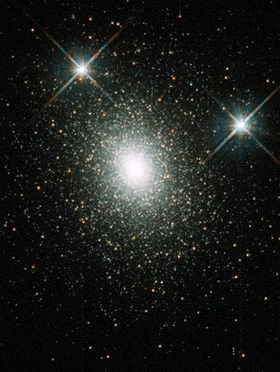- Mayall II
-
Mayall II 
Hubble Telescope image of Mayall II, colour picture assembled from separate images taken in visible and near-infrared wavelengths in July 1994.
Credit: Michael Rich, Kenneth Mighell, and James D. Neill (Columbia University), and Wendy Freedman (Carnegie Observatories) and NASAObservation data (J2000 epoch) Constellation Andromeda Right ascension 00h 32m 46.51s[1] Declination +39° 34′ 39.7″[1] Distance 2.52 ± 0.14 Mly (770 ± 40 kpc) Apparent magnitude (V) +13.8[1] Physical characteristics Mass 1×107[2] M☉ (2×1037 kg) Radius 21.2 ± 1.0 ly (6.5 ± 0.3 pc) (Half light radius rh)[3] Estimated age ~ 12 Gyr [2] Other designations SKHB 1, HBK 0-1[1] See also: Globular cluster, List of globular clusters Mayall II (M31 G1) also known as NGC-224-G1, SKHB 1, GSC 2788:2139, HBK 0-1, M31GC J003247+393440 or Andromeda's Cluster is a globular cluster orbiting M31, the Andromeda Galaxy.
It is located 130,000 light-years (40 kpc)[3] from Andromeda's galactic core, and is the brightest[3] (absolute magnitude) globular cluster in the Local Group, having an apparent magnitude of 13.7. G1 is considered to have twice the mass of Omega Centauri. G1 may contain a central, intermediate-mass (∼ 2×104 M⊙) black hole.[3]
It was first identified as a possible globular cluster by Nicholas Mayall & O.J. Eggen in 1953 using a Palomar 48-inch Schmidt plate exposed in 1948.[3]
Because of the widespread distribution of metallicity, indicating multiple star generations and a large stellar creation period, many contend that it is not a true globular cluster, but is actually the galactic core that remains of a dwarf galaxy consumed by Andromeda.[3][4]
Contents
Origin of names
Mayall II is named after Nicholas U. Mayall, who, with O.J. Eggen, discovered it in 1953.
SKHB 1 is named for Wallace L. W. Sargent, C.T. Kowal, F.D.A. Hartwick, and Sidney van den Bergh. They also named it G1 in 1977.
HBK 0-1 is named for J.P. Huchra, J.P. Brodie, and S.M. Kent in 1991.
See also
- Mayall III (M31 G2, G2, HBK 0-2, SKHB 2, M31GC J003334+393119)
- Mayall IV (HBK 358-219, SKHB 219, Bol 358, M31GC J004318+394914)
- Mayall V (HBK 407-352, SKHB 352, Bol 407, M31GC J005010+414101)
- Mayall VI (HBK 0-327, SKHB 327, BA 3-29, M31GC J004650+424445)
- Mayall's Object (Arp 148 or APG 148, VV32)
References
- ^ a b c d "SIMBAD Astronomical Database". Results for Mayall II. http://simbad.u-strasbg.fr/Simbad. Retrieved 2009-09-13.
- ^ a b Ma, Jun; de Grijs, Richard; Fan, Zhou; Rey, Soo-Chang; Wu, Zhen-Yu; Zhou, Xu; Wu, Jiang-Hua; Jiang, Zhao-Ji; Chen, Jian-Sheng; Lee, Kyungsook; Sohn, Sangmo Tony (June 2009). "RESEARCH PAPER: Old stellar population synthesis: new age and mass estimates for Mayall II = G1". Research in Astronomy and Astrophysics 9 (6): 641–652. Bibcode 2009RAA.....9..641M. doi:10.1088/1674-4527/9/6/003.
- ^ a b c d e f Ma, J.; de Grijs, R.; Chen, D.; van den Bergh, S.; Fan, Z.; Wu, Z.; Wu, H.; Zhou, X.; Wu, J.; Jiang, Z.; Chen, J. (April 2007). "Structural parameters of Mayall II = G1 in M31". Monthly Notices of the Royal Astronomical Society 376 (4): 1621–1629. arXiv:astro-ph/0702012. Bibcode 2007MNRAS.376.1621M. doi:10.1111/j.1365-2966.2007.11573.x.
- ^ Meylan, G.; Sarajedini, A.; Jablonka, P.; Djorgovski, S. G.; Bridges, T.; Rich, R. M. (August 2001). "Mayall II=G1 in M31: Giant Globular Cluster or Core of a Dwarf Elliptical Galaxy?". The Astronomical Journal 122 (2): 830–841. arXiv:astro-ph/0105013. Bibcode 2001AJ....122..830M. doi:10.1086/321166.
External links
Categories:- Andromeda Galaxy
- Globular clusters
Wikimedia Foundation. 2010.
